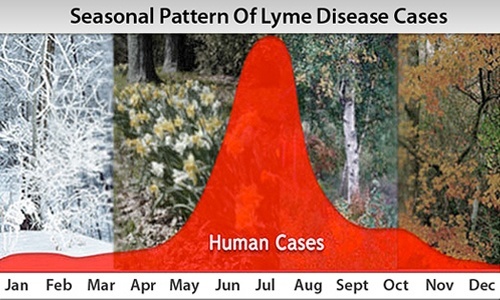


Lyme disease, the most common American tick-borne infectious disease, often goes undiagnosed or becomes misdiagnosed. That becomes a real problem when you consider that in America, up to 300,000 new cases a year of Lyme disease diagnoses have been reported by the Centers for Disease Control and Prevention (CDC), an increase of up to 10 times what researchers previously believed.
Lyme disease, or borreliosis, is caused by the bacterium Borrelia burgdorferi, which can proliferate to every area in your body. An infected blacklegged deer tick transmits the virus to humans through a bite.
Unfortunately, Borrelia burgdorferi has the ability to proliferate within every area of your body, hiding from and suppressing your natural immune system. Lyme infections literally hijack your immune system like AIDS.
Lyme is one of the most challenging, difficult situations in my practice because it mimics other illnesses such as the flu, manifesting as diverse symptoms like headaches, muscle aches, stomach ulcers, constipation, and joint pain. That makes diagnosing and treating Lyme very difficult.
A weakened immune system paired with suboptimal cellular function and protection, chronic bacterial infections, and exposure to environmental toxins, like molds and parasites, can make things much worse for those who suffer from chronic Lyme.
Some of my patients who are diagnosed with Lyme have struggled for years with undiagnosed symptoms that conventional doctors overlooked.
My own dentist had a chronic inflammatory problem that no one could figure out. After copious sleuthing, it turns out he had a tick-borne infection. Just as bad, my patients have been misdiagnosed. Dr. Dietrich Klinghardt believes conventional doctors misdiagnose many cases of Lyme as fibromyalgia.
Left unchecked, Lyme symptoms worsen, creating a long-running inflammatory response and autoimmune illness. Early treatment can be successful but many go undiagnosed for years.
Although I believe antibiotics become necessary for treating Lyme, many conventional doctors stop there. But to truly recover from Lyme disease, you want to work with a practitioner who takes a whole-system approach rather than simply believing a few courses of antibiotics will make things better.
If you suspect Lyme, the first step is to complete the Horowitz Lyme-MSIDS Questionnaire. This will help you pinpoint many Lyme-related symptoms and their severity.
If you believe you have Lyme, please visit your doctor to confirm your suspicion. Needless to say, the sooner you address these conditions and begin treatment, the more effectively you will recover.
The most popular conventional way to test for Lyme disease is a combination of the Western blot and ELISA test, which measure specific antibodies in the blood.

 233k
233k  41k
41k  Subscribe
Subscribe 
